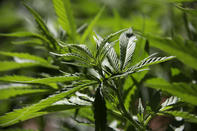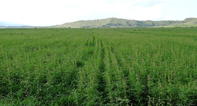Hemp - a low type of Cannabis sativa with a low level of the cannabinoid THC - is a wind-pollinated, annual broadleaf plant with a taproot. It is cultivated for its production of long fibres for textiles, hemp seeds for oil and other uses.

Under optimum conditions, hemp germinates within three to five days. It is a fast grower, generally requiring about 120 days to mature, preferably under warm and light conditions. The yield of seeds and biomass (stems and leaves) is lower in dark and cooler climates.
Hemp is a high-production crop that can yield more oil than peanuts and up to four times as much paper pulp than trees on the same size of land. Hemp can also be farmed hydroponically (farming that only uses water and essential nutrients, and not soil).
Soil Preparation for Hemp
Hemp grows best in well-drained loam soil with a pH of between 6 and 7.5 with abundant organic matter - at least 3.5 %. Dense, poorly-drained clay soil is not suitable and sandy soil’s need for extra irrigation and fertilising may be uneconomical.
Seedbed preparation is important; firm and fine is best in order to plant hemp seeds between 2 - 3cm deep. Hemp is sensitive to frost during germination and requires water during the first six weeks after planting.
Fertilisation of hemp should be based on soil analyses, but in general, the addition of nitrogen, potassium, phosphorus and sulphur are advised. Calcium should not be more than 6 000 ppm.
When to Plant Hemp
As stated by the Agricultural Research Council’s industrial crops facility, the hemp plant is sensitive to short day length. Subsequently, planting date is an important factor to optimise fibre hemp production.
Hemp requires long warm summers and a day-length of between 14 and 16 hours. An early planting date such as October to November in the Eastern and Western Cape will result in taller plants with higher fibre yields. Short days cause early flowering and reduced leaf growth, which in turn creates reduced fibre production.
Planting Width of Hemp

Row spacing and seeding rate (how many seeds to sow in a specific area) are important factors in hemp production because they influence the growth, biomass production and fibre yield of the hemp plant, says the ARC. High seeding rate and narrow spacing between rows will produce tall-growing plants that will produce long fibres and less seed. Planting width and density are determined by the type of hemp, i.e. oil, fibre or seed. For example, densities for seed production of tall, European, dual-purpose cultivars are less than short oilseed hemp cultivars.
Pests and Diseases of Hemp
Hemp is easy to grow organically. It requires few if any pesticides as it grows quick and attracts few pests. In fact, the crop kills some weeds, purifies soil and is suitable for crop rotation, due to its short harvest cycle of around 120 days.
Hemp can be grown as a rotational crop with grain crops such as bean, wheat and lucerne to prevent pathogen and disease build-up. Studies in Canada, however, indicated that hemp should not be planted after canola, soybeans or sunflowers due to the risk of Sclerotinia stem rot (white mold).
Harvesting Hemp
Harvesting hemp for fibre is easier than harvesting hemp for the hemp seed. To harvest hemp grown for fibre, implements used for the harvesting of forage crops can be used, which generally perform well without major modifications.
A straight sickle mower is the most suitable for harvesting hemp for textile applications. This implement leaves cut stems intact, laid neatly and organised directly on the ground. Haybines do not work well as the long stems wrap on the reel. Cut no shorter than 10 cm above the soil surface.
Hemp (for seed production) is ready to harvest when the seed bracts have dried and the seeds are exposed. Frost will assist the drying process and generally, harvesting will commence a few days after a frost. An average yield of 750 kg/ha is achieved in Canada.
Permits for Growing Hemp
Hemp farmers in South Africa import seeds and need a special permit to allow for the importation of a ‘controlled substance’. Seed permits are issued by the Department of Agriculture, Forestry and Fisheries (DAFF). They are only allowed to plant the certified seed of an approved variety which has less than 0.1% THC. Seeds are obtained from the Czech Republic, Spain, the USA and France.
The permit for growing hemp in South Africa currently is performed under ‘research’ and is not available for the commercial production of hemp. Prospective hemp farmers must submit research proposals with their applications. Application forms can be obtained from the South African Health Products Regulatory Authority (SAHPRA) offices and will cost R902 (2019).
In Canada, hemp farmers that need permission to farm hemp must supply GPS coordinates of the corners of the hemp production area, a map of hemp production area showing landmarks and roads, the name of hemp variety to be grown and a police security check.
By Marinda Louw